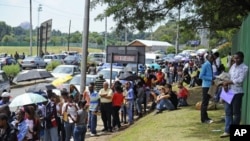A stampede to register for limited slots at a Johannesburg university this week resulted in one death and dozens of injuries. The tragedy has resulted in intense attention on South Africa’s higher education system and its many problems.
Last month, some 250,000 South Africans passed their final high school exams at a level that qualified them for admission to universities and diploma colleges. But those institutions this year only have 180,000 places for first-year students.
The University of Johannesburg, where the deadly stampede occurred, received 85,000 applications for 11,000 first-year slots. Graeme Bloch, a visiting adjunct professor at the University of the Witwatersrand, said the stampede is indicative of desperation to build a future among South Africa’s youth.
“It is all about young people who want opportunities. And quite honestly it is about a school system that is slowly improving, and as a result young people think that getting through the school system is going to get them somewhere, and then when they find that they have to stand in queues [lines] at the University of Johannesburg, they stampede; and I think it expresses that desperation that we are seeing
from young people,” said Bloch.
Late walk-in application policy criticized
Much criticism has been leveled at the university for allowing its system of accepting late walk-in applications by certain applicants. Higher Education Minister Blade Ndzimande last year scoffed at criticism of the long lines outside the university, calling it a "wonderful problem" that so many young South Africans were determined to get a higher education.
This week, Ndzimande said the government will centralize applications for universities and colleges, and will not permit late walk-in applications.
Some analysts noted this week that as many as 40 percent of students drop out of the university without achieving a degree. They say one of the causes is that the drop-outs should have enrolled in vocational colleges, known in South Africa as further education and training colleges.
Vocational schools under fire
Many employers criticize the vocational institutions, however, for failing to produce graduates who have the knowledge and skills that equip them for employment. Critics say that often the teachers themselves are ill qualified or that the institutions are not offering training relevant to potential employers in their area.
But there are problems, too, in basic education. Shireen Motala, director of research in the Post Graduate Studies department at the University of Johannesburg, said the access to basic education in South Africa is not a problem, and that most children stay in school until about sixteen. She noted, though, that less than 50 percent of children who start school write their final high school examination,
known in South Africa as “matric."
“In fact of the cohort who sat the [high school exam] in 2011, and those who started in 2000, only about, I think, around 45 percent survived, which means that a large number of children are falling by the wayside and the concern is that where do those learners actually go to,” said Motala.
Improved skills for teachers
Experts say many historically disadvantaged schools in rural areas and townships are dysfunctional because the principals or the teachers, or both, are failing. They say in some cases it is not dereliction of duty, but that many simply do not have the skills or appropriate training for their jobs, particularly in the important subjects of math and science. Motala said there are a number of reasons for these weaknesses.
"So I think a number of teachers were trained during apartheid, which means the training was not up to standard. Secondly, we’ve had many processes of curriculum reform in the last 15 years, which I think has been quite confusing for teachers. And finally there is the big issues of language, which we haven’t taken enough cognizance of, but I think is a huge problem," said Motala.
Language is a problem because subjects, such as math and science, are taught in English from about age 10, and many teachers don’t have the English language skills to do so.
Motala said a further difficulty for teachers is that the curriculum has been changed several times over the past 15 years.
Deadly Stampede Highlights Problems With South African Universities






